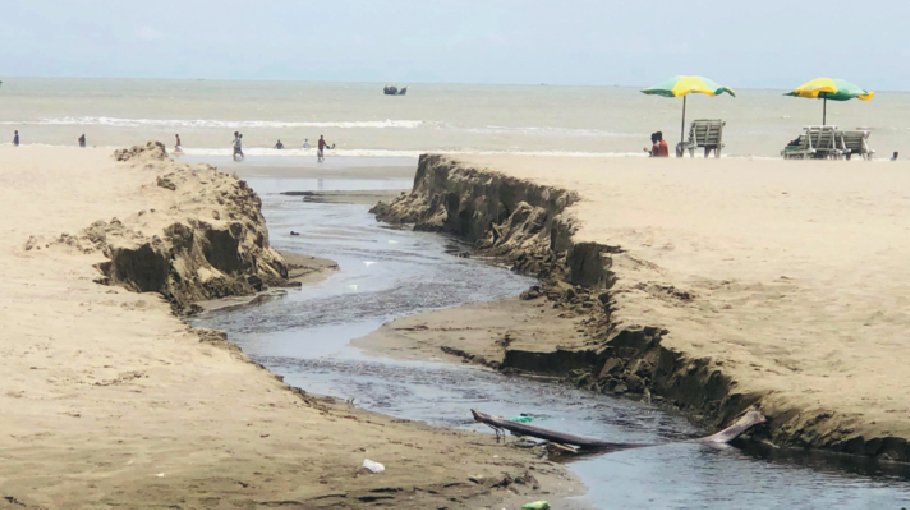Hidden canals pose threat to Cox’s Bazar tourists

Two commercial establishments have jointly dug an artificial canal by cutting sandy beach of the world’s longest natural sea beach in Cox’s Bazar. A dam has been constructed to block the natural water flow before excavating the canal.
This has disrupted the continuity of the beach and raised serious concerns about severe erosion of the sand dunes.
Experts warn that pits and hidden channels may also form along the beach, creating hazards for tourists wanting to swim safely in the sea. Environmentalists have also voiced concern that wastewater from the hotel-motel zone is now directly flowing into the sea through the artificial canal, polluting the marine environment.
The artificial canal can be seen next to the Divine Eco Resort, near the Kolatoli point of Cox’s Bazar beach. Local tourism business owners said that previously, water from some parts of the hotel-motel zone naturally flowed through a small stream beside the resort and entered the sea near the Pacific Beach Lounge Café. However, during the monsoon, the owners of the café blocked the stream with sandbags to construct a dam. As a result, water accumulated in front of the Divine Eco Resort, forming a large and deep pond. To drain this stagnant water, an artificial canal was cut through the sand dunes at the southwest corner of the resort.
Now, both rainwater and storm water regularly flow in the sea through the canal, and due to tidal activity, the canal is widening. This process is gradually breaking up the uninterrupted beach.
According to local businesspeople, labourers hired by Pacific Beach Lounge Café and Divine Eco Resort excavated the canal.
Dipak Sharma Dipu, president of the Cox’s Bazar Forest and Environmental Conservation Council, said that the two establishments carried out this astonishing act for personal benefit. Now, polluted wastewater from the hotel-motel zone is flowing into the sea daily, and during heavy rainfall, the canal is expanding. As a result, the continuous stretch of the world’s longest sea beach is being fragmented, and the sea is becoming polluted and less attractive. Moreover, constant water flow through the canal has created permanent pits and hidden channels on the beach, increasing the risk to tourists and potentially leading to fatalities.
He urged the administration to take immediate action.
Mohammad Shukkur, a senior member of the Sea Safe Lifeguard organisation responsible for the beach, said that during the recent monsoon, several pits and hidden channels have formed in various areas of the beach. Eight tourists died while swimming due to these hazards. It is extremely difficult to identify naturally formed pits and hidden channels.
He added that these features typically form due to the combination of runoff from nearby areas during the monsoon and the force of the sea waves.
The artificial canal between Sugandha and Kolatoli points has greatly increased the risk of such formations. It has also accelerated erosion along the sand dunes.
When asked, Javed Iqbal, General Manager of Pacific Beach Lounge Café, said that erosion began in front of their establishment due to water flow. To prevent this erosion and facilitate tourist movement, they built a dam on the natural stream.
He stated, “Why should water flow in front of my property? That’s why we built the dam.” However, he denied knowing who dug the canal.
Mohammad Selim, a representative of Divine Eco Resort, acknowledged that a dam was constructed on the natural water path, causing erosion near their property. As an alternative, water is now flowing through a new channel, which he confirmed was artificially dug. However, he denied their involvement and said he did not know who created it.
Meanwhile, some tourists expressed frustration over the disruption caused by the canal, as it has broken the continuity of the beach. They also raised concerns about safety risks, pollution, and the diminishing beauty of the beach.
Cox’s Bazar Deputy Commissioner Mohammad Salahuddin said the district administration would investigate and take action if anything illegal is found.



